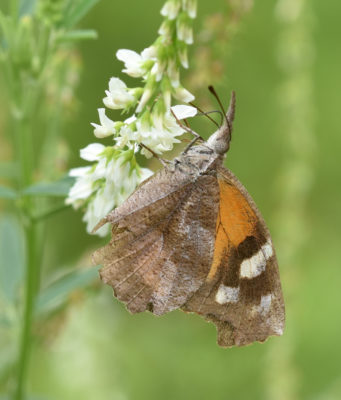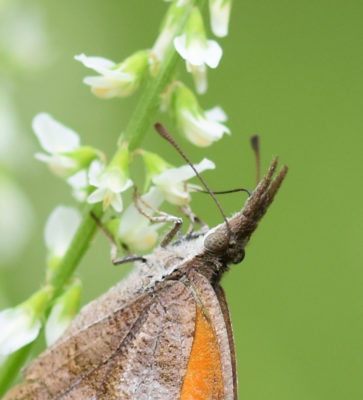In July (of 2017) I started seeing reports from across southern Ontario of sightings of a butterfly I’d never heard of before called an “American Snout.” Of course, I really, really wanted to be able to casually mention (i.e. brag) that I’d seen one too but I didn’t want to drive for an hour or more to look for a butterfly smaller than a Monarch in a park the size of several city blocks. (My kids will tell you I can be a few feet from a bird as large as a Robin and still be saying “Where? Where?” when they are pointing at it.) So I figured I’d look very closely at Jack Darling Park and the Rattray Marsh. The two adjoining parks are some of the largest green spaces in west Mississauga with a wide variety of habitats that might be welcoming to a tired butterfly arriving from the US. And there’s usually something interesting to see there, whether it’s an odd red-juice covered fungus or an unexpected bird so if I didn’t find the butterfly I might still have an adventure.
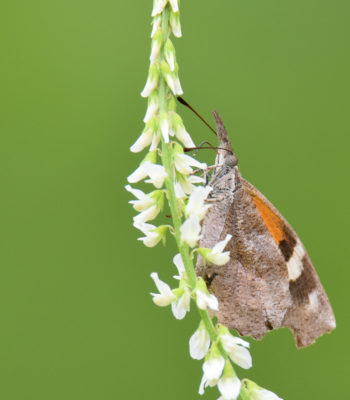
And I did find one! I didn’t see it the first time I passed the meadow near the Bexhill Street entrance to the Rattray, but I spotted it the second time I stopped to check out the butterflies.
What Butterfly Looks a Bit Like a Comma or Painted Lady But Has a Really Long Brown Nose Like an Anteater?
The American Snout butterfly seems to have a reasonable name:
It’s found in the USA especially in the southern US, but also in Central and South America making it truly “American.”
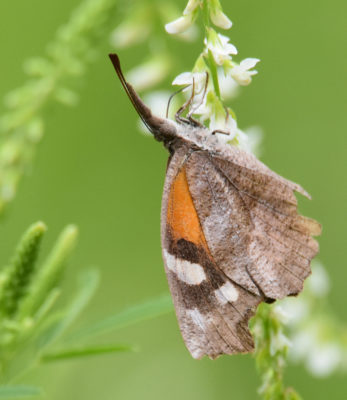
It’s “snout” looks extra long in this photo because the antenna are in line with the tip. I noticed it moved its antenna around quite a bit while sipping sugar.
And it definitely has a “snout.” In fact, that was the reason I was almost positive I had found one when I first spotted it. I took a zillion photos, of course, in case it was something else but I had never seen a face like that on another butterfly before. (I have seen “snouts” on some moths.)
Do American Snout Butterflies Migrate to Ontario?
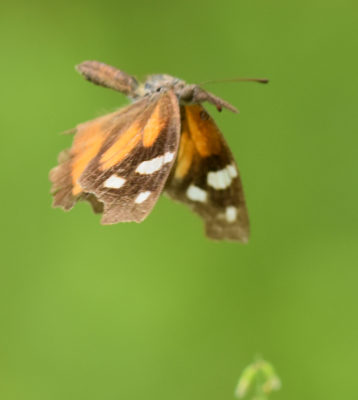
They are quite bright when they fly but can cover up all of the orange in their wings when they perch if they want to blend in with a tree trunk.
According to THE ROM FIELD GUIDE TO butterflies of ONTARIO (that’s the way it’s written on the cover) American Snouts are a “rare to uncommon breeding migrant” to Ontario. In other words, some of the ones that mature in the US fly north to lay eggs up here. Their offspring live in Ontario but do not appear to over-winter. (They might possibly over-winter in some locations but at the time the book was written that had not been proven.) It doesn’t mention whether any of them try to move south again in the cooler fall weather.
Judging by the comments I read from some of the other people who found them this summer, I don’t think they appear in Ontario consistently each year. I think some years they are more numerous than others.
Where Should I Look for an American Snout?
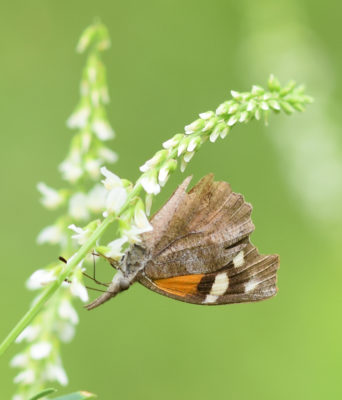
The Snout seemed to like feeding upside down.
One problem I have when trying to find a new type of butterfly is knowing where to look. Eastern Commas and Mourning Cloaks, for instance, are more likely to be found on tree cracks sipping sap than on flowers. Banded Hairstreaks seem to like to perch on leaves on saplings about 2-3 metres above the ground along the edges of paths. I wasn’t sure where to even start looking for the Snout.
They lay eggs on Hackberry trees for their caterpillars to eat. Unfortunately, I have no idea what a Hackberry tree looks like so that didn’t help me much.
I looked at online photos of Snouts and they showed the butterflies are sometimes found on flowers. So when I saw other butterflies (Eastern Tailed Blues, Monarchs, and various skippers) enjoying some thistles and White Sweet Clover at the Rattray, I stopped to look very closely. And suddenly, there one was!
Maybe It Should be the American Beaked?
The “snout” is actually split, as I found when watching the butterfly closely. The black proboscis (I didn’t used to be able to spell that word…I still can’t pronounce it.) seems to be coming out from between the two parts but I’m not sure if that’s accurate or not.
I had a wonderful time seeing this new (to me) type of butterfly. I haven’t got a chance yet to brag about it but I’m hoping to sometime this fall!
Related Reading
- This article includes an interesting photo of some Hackberry tree bark which might help me find one in the future
- A Buckeye Butterfly at Jack Darling
Join In
Did you see one of the “American Snouts of Summer” this year? Please share your sighting with a comment.

